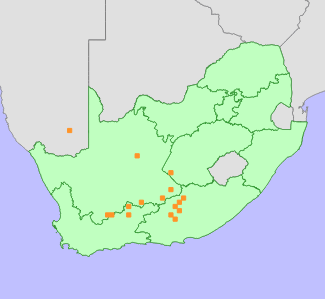|
Scientific Name | Ceropegia filiformis (Burch.) Schltr. |
Higher Classification | Dicotyledons |
Family | APOCYNACEAE |
Synonyms | Ceropegia infundibuliformis E.Mey. |
Common Names | Rankkambroo (a), Soetwortel (a) |
National Status |
Status and Criteria | Least Concern |
Assessment Date | 2019/11/04 |
Assessor(s) | D. Raimondo, P.V. Bruyns & L. von Staden |
Justification | Ceropegia filiformis is widespread, with an extent of occurrence (EOO) of more than 200 000 km². While this species has rarely been recorded and it is possibly rare, there is also the possibility that it has been overlooked as it is highly inconspicuous. It is not suspected to be in danger of extinction, and is therefore listed as Least Concern. |
Distribution |
Endemism | Not endemic to South Africa |
Provincial distribution | Eastern Cape, Free State, Northern Cape, Western Cape |
Range | This species is widespread across the arid regions of South Africa and Namibia, from south-eastern Namibia to Griekwastad, and southwards to Merweville and Somerset East. |
Habitat and Ecology |
Major system | Terrestrial |
Major habitats | Eastern Upper Karoo, Northern Upper Karoo, Upper Karoo Hardeveld, Karoo Escarpment Grassland |
Description | Plants scramble in the open among rocks, or inside karroid shrubs on sandy plains and plateaus. |
Threats |
| Dyer (1969) suggested that the lack of records for Ceropegia filiformis may be due to habitat degradation due to overgrazing, which has had a wide-ranging impact across the Great Karoo. However, the lack of records is more likely explained by a lack of survey effort, the cryptic nature of plants, and the fact that they only emerge from dormancy sporadically in years of good rainfall. The southern sections of this species' range may be severely impacted if planned widespread shale gas fracking is to go ahead. |
Population |
This species is widespread across the arid central region of South Africa, but is known from only a few collections. It is probably the most inconspicuous of all Ceropegia species (Bruyns 1995), and likely to be overlooked. In addition, plants only appear out of dormancy in years of very good rainfall (Dyer 1969), and the majority of its range falls within the botanically most poorly explored areas of South Africa. It is therefore likely to be more common than records suggest. Dyer (1969) suggested that it may have declined due to overgrazing, but there has been no population monitoring, and current population trend is not known. Bruyns (1985) indicates that subpopulations are small, consisting of single plants or only a few individuals.
|
Population trend | Stable |
Assessment History |
Taxon assessed |
Status and Criteria |
Citation/Red List version | | Ceropegia filiformis (Burch.) Schltr. | Least Concern | Raimondo et al. (2009) | | Ceropegia filiformis (Burch.) Schltr. | Rare | Hilton-Taylor (1996) | |
Bibliography |
Bruyns, P. 1995. New records and new species of Asclepiadaceae from Namibia. Bothalia 25(2):155-172.
Bruyns, P.V. 1985. Notes on Ceropegias of the Cape Province. Bradleya 3:1-47.
Bruyns, P.V. 2014. The Apocynaceaea of Namibia. Strelitzia 34. South African National Biodiversity Institute, Pretoria.
Dyer, R.A. 1969. Ceropegia filiformis. Flowering Plants of Africa 40:t. 1580.
Dyer, R.A. 1980. Brachystelma, Ceropegia and Riocreuxia. In: O.A. Leistner (ed). Flora of Southern Africa 27 Part 4:1-88. Botanical Research Institute, Pretoria.
Hilton-Taylor, C. 1996. Red data list of southern African plants. Strelitzia 4. South African National Botanical Institute, Pretoria.
Raimondo, D., von Staden, L., Foden, W., Victor, J.E., Helme, N.A., Turner, R.C., Kamundi, D.A. and Manyama, P.A. 2009. Red List of South African Plants. Strelitzia 25. South African National Biodiversity Institute, Pretoria.
|
Citation |
| Raimondo, D., Bruyns, P.V. & von Staden, L. 2019. Ceropegia filiformis (Burch.) Schltr. National Assessment: Red List of South African Plants version 2024.1. Accessed on 2025/10/24 |
 Comment on this assessment
Comment on this assessment

